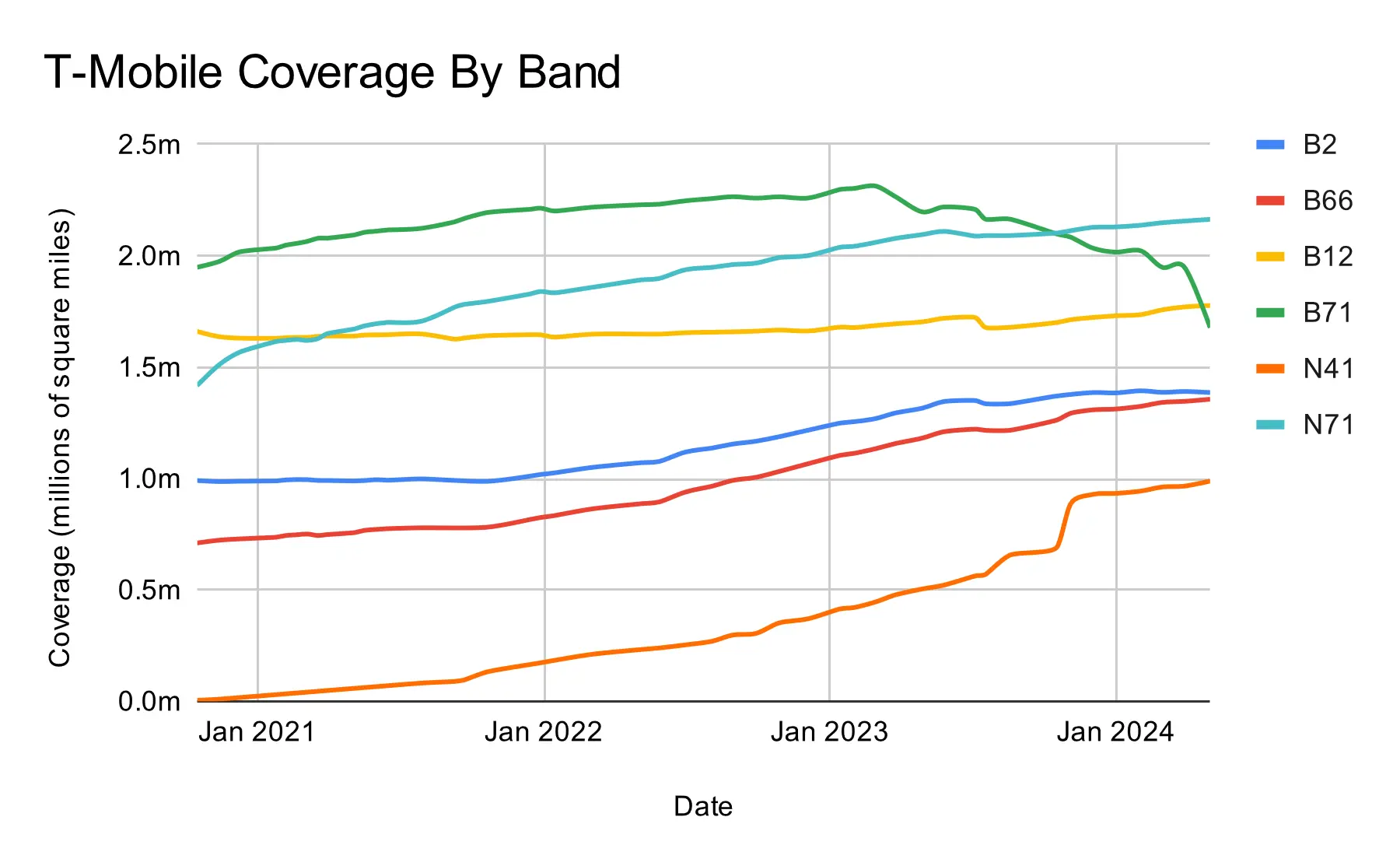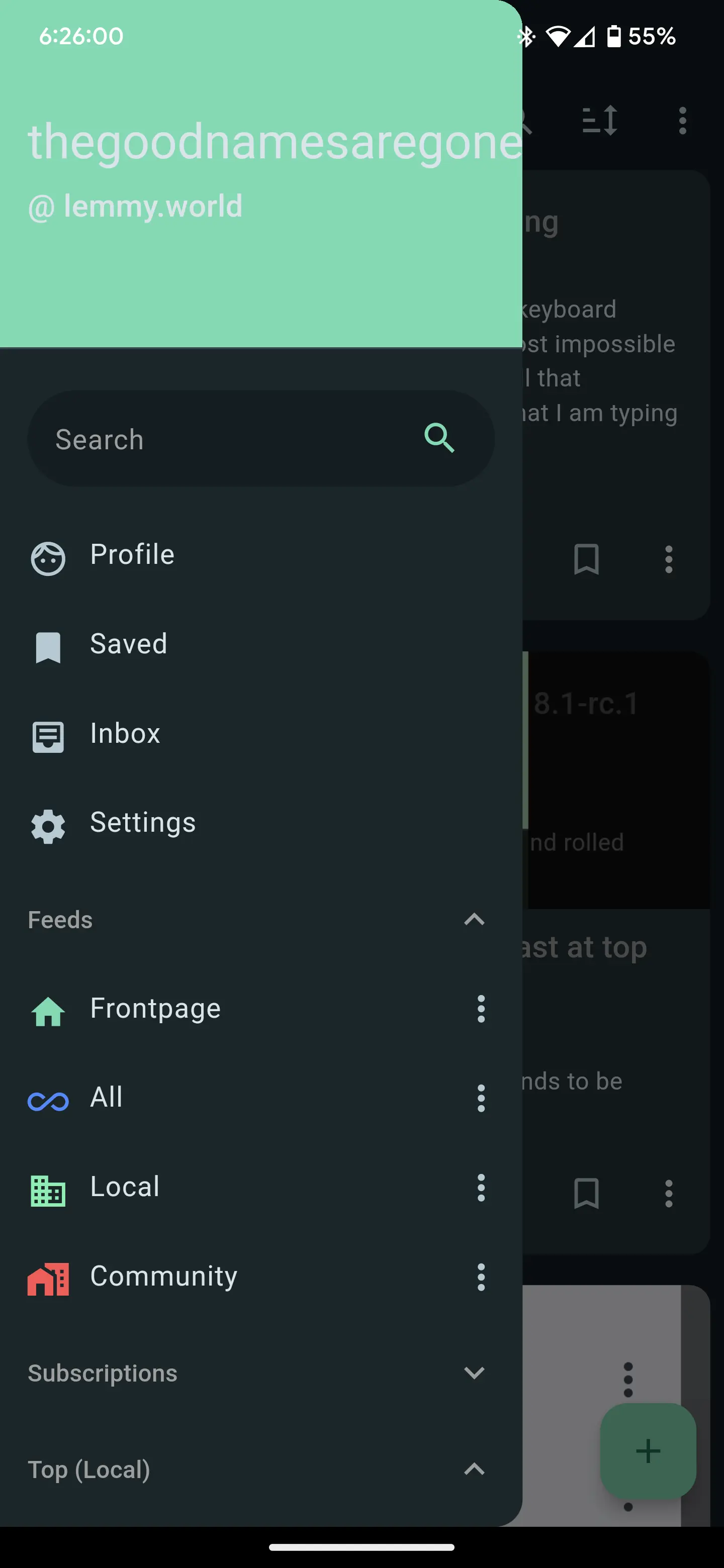At no point has T-Mobile included band 41 in this data.
They also exclude band 5 (which is only in Myrtle Beach, SC), band 13 (only in Puerto Rico), bands n258/n260/n261 (5G mmWave), band 46 (uses the same wireless spectrum as Wi-Fi, T-Mobile has only deployed it in a few spots of some cities), and some bands that T-Mobile has so far only deployed for testing purposes (ex. Band 48, n77) with a larger launch coming in the future.
The data I'm pulling from does include some 2G, 3G, and roaming information, but I decided to exclude that data to avoid the graph becoming too busy and hard to read.
T-Mobile US Coverage By Band


Here is a chart showing how T-Mobile US's coverage has changed over the past 3.5 years on each band. Data comes from T-Mobile.
You're on Google Fi, so that's not real. You realize being with an MVNO means you're de-priorotized on the network right?
Afaik Google Fi is actually the only MVNO that isn't deprioritized on T-Mobile's network.
T-Mobile’s Ultra Capacity 5G Now Covers 330 Million People
No, it does not.
According to both T-Mobile and the article you linked T-Mobile's 5G Ultra Capacity covers 300 million people while T-Mobile's overall 5G network (which includes the much slower and longer range 5G Extended Range) covers 330 million people.
Here's T-Mobile's statement yesterday:
300 million Americans now covered by Ultra Capacity 5G, achieving the year-end goal more than two months ahead of schedule, while the total 5G network covers more than 330 million people (98% of Americans)
As I understand, 5G mobile networks are IPv6 native, there is an IPv4 compatibility layer but it's limited and not useful for my needs.
A few slight nitpicks:
First of all, 5G networks can support both IPv4 and IPv6, it's just certain carriers (such as T-Mobile) that are IPv6-only.
Secondly, T-Mobile uses a more advanced IPv4 compatibility layer than most other IPv6-only ISPs that avoids most of the normal issues of IPv4 compatibility layers.
I suspect that the cause of your problems is likely T-Mobile's restrictive, non-configurable, network side firewall. The IPv4 compatibility layer may have contributed to it being implemented this way as the compatibility layer does make other firewall setups more complicated but still possible (with PCP), however I suspect that the main reason it is setup this way is because this setup is fine with cell phones (what T-Mobile's network was originally designed for) so T-Mobile didn't see any reason to do anything differently.
It is possible to bypass this firewall using a VPN. In fact T-Mobile Business Internet even offers a VPN that integrates with T-Mobile ISP pretty seamlessly and with minimal latency penalty. Or you can just use a different VPN, but first look into the firewall setup of that VPN. IIRC some users have used the free virtual private servers that Oracle offers to setup their own VPN for this for free, although that's a bit more advanced.
I replaced spectrum with T-Mobile Home Internet and it mostly works pretty well. Far cheaper than spectrum, even after spectrum offered a temporary better price when we canceled.
I've been getting around triple the download bandwidth and eight times the upload bandwidth with lower latency to IPv6 services (IPv4 services have slightly higher latency because T-Mobile's network is IPv6-only and uses a translation layer to enable IPv4 to work).
Oops, fixed now.
When creating this community I also created !verizon@lemmy.world at the same time and evidently I screwed up some copy and pasting.
Seconded, also it would be nice if usernames were clickable above posts and comments.
(Edit: Fixed as of 1.0.44) Bug: Long usernames are cut off and hide the switch accounts button


The app cannot handle the length of my username, resulting in it being cut off and the button to switch accounts, add an account, and sign out being hidden.
Edit: Also, the swipe action for downvote seems to upvote instead.
Edit 2: Correction, the swipe action seems to depend on how quickly I do it. If I do the gesture quickly it upvotes no matter what.
Edit 3: Seems to be fixed as of 1.0.44.
I've seen a lot of these utility pole setups for Verizon in Evanston, measured with my phone.
In that case it probably is Verizon.
My main question was the T-Mobile, since I'm definitely no expert, but the antenna setup does look different than a lot of more recent T-Mobile deployments.
A tall and skinny antenna in the center with 2 or 3 shorter (and still somewhat narrow) antennas around it was a pretty common T-Mobile setup for a few years.
T-Mobile started deploying that setup when they obtained their band 12 licenses (which for several years were T-Mobile's main long range licenses).
Once T-Mobile bought their band 71 licenses (which are now T-Mobile's main long range licenses) they stopped deploying that setup and instead used a big antenna that not only supported their new band 71 licenses, but also was able to squeeze theoretically double the capacity out of each of T-Mobile's long range licenses and on more recent equipment (~2019+) could even integrate some medium range license support into the same antenna panel (meaning less pieces of equipment are needed now).
Really appreciate it, and tbh I was a bit surprised to get any reply on such a new platform. Thank you!
Welcome to this community!
I am hopeful that this community gains some popularity. Currently the main Cellmapper communities are on Reddit (which I wouldn't be here if I was still happy with them) and Telegram (which IMO is not a good format for these kinds of content), which is why I created this Lemmy community.
The utility pole setup is hard to confirm as I've seen setups similar to that from a lot of carriers. However I've seen it most often from Verizon and AT&T so if Verizon has a good signal around there it is probably Verizon.
The building setup does look like T-Mobile, although not a particularly recent setup. Center antenna looks like LTE band 12, outer antennas are likely bands 2 and 4/66. Possibly 5G n25 (I've seen equipment as old as 2012 get FCC approval to have 5G capabilities added through software, although the performance isn't a whole lot better than with 4G because in those cases the hardware isn't designed to take advantage of 5G's capabilities).